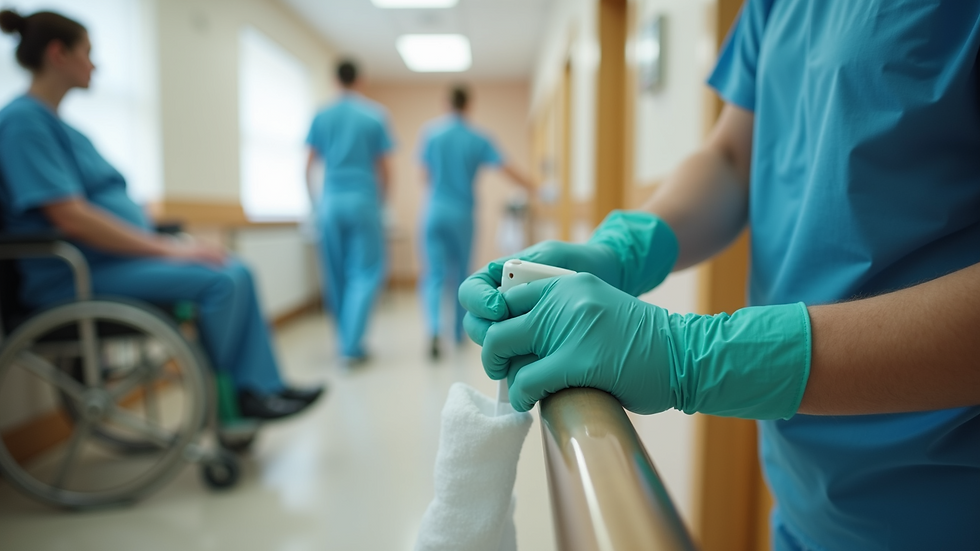Ensuring Safety in Care Homes Through Thorough Cleaning
- office335092
- Aug 4
- 3 min read
Maintaining a clean and safe environment in care homes is essential for the health and well-being of residents. Care homes accommodate vulnerable individuals who require extra attention to hygiene and safety standards. A thorough cleaning routine not only prevents the spread of infections but also creates a comfortable and welcoming atmosphere. This article explores the importance of resident-focused cleaning services and practical steps to ensure safety through effective cleaning.
The Importance of Resident-Focused Cleaning Services
Resident-focused cleaning services prioritise the unique needs of care home residents. These services go beyond basic cleaning to address specific health risks and comfort requirements. For example, residents with compromised immune systems or chronic illnesses are more susceptible to infections. Therefore, cleaning protocols must be stringent and tailored to minimise these risks.
Key benefits of resident-focused cleaning services include:
Infection control: Reducing bacteria, viruses, and fungi on surfaces to prevent outbreaks.
Allergen reduction: Removing dust, pet dander, and other allergens that can trigger respiratory issues.
Comfort and dignity: Ensuring residents live in a clean, pleasant environment that respects their dignity.
Compliance: Meeting regulatory standards for hygiene and safety in care settings.
Implementing these services requires trained staff who understand the specific challenges of care homes. They use specialised cleaning agents and equipment designed to be safe for residents while effective against pathogens.

How Resident-Focused Cleaning Services Enhance Safety
Safety in care homes is closely linked to hygiene. Resident-focused cleaning services enhance safety by:
Targeting High-Touch Areas: Door handles, light switches, handrails, and call buttons are cleaned frequently to reduce germ transmission.
Using Safe Cleaning Products: Non-toxic, hypoallergenic products protect residents from chemical exposure.
Regular Linen and Laundry Care: Bedding and clothing are washed at high temperatures to kill bacteria and viruses.
Waste Management: Proper disposal of medical and general waste prevents contamination.
Staff Training: Cleaning staff receive ongoing training on infection control and resident interaction.
These measures reduce the risk of infections such as MRSA, norovirus, and influenza, which can spread rapidly in communal living spaces.

What is done during a deep cleaning?
Deep cleaning in care homes involves a comprehensive approach that goes beyond daily cleaning routines. It targets hidden dirt, grime, and pathogens in areas that are often overlooked. The process typically includes:
Detailed Surface Cleaning: Walls, ceilings, vents, and behind furniture are cleaned to remove dust and mould.
Floor Care: Carpets are shampooed, and hard floors are scrubbed and polished.
Sanitising Bathrooms and Kitchens: These high-risk areas receive intensive cleaning to eliminate bacteria and viruses.
Furniture and Equipment Cleaning: Chairs, tables, wheelchairs, and medical equipment are thoroughly disinfected.
Air Quality Improvement: Ventilation systems are cleaned to reduce airborne contaminants.
Deep cleaning is usually scheduled periodically and is essential after outbreaks or when preparing for new residents. It complements daily cleaning and ensures a higher standard of hygiene.

Practical Recommendations for Maintaining Cleanliness and Safety
To maintain a safe environment, care homes should adopt the following practical steps:
Develop a Cleaning Schedule: Create a detailed timetable covering daily, weekly, and monthly tasks.
Use Checklists: Ensure all areas and items are cleaned consistently and nothing is missed.
Invest in Quality Equipment: Use HEPA-filter vacuums, microfiber cloths, and effective disinfectants.
Encourage Resident Participation: Educate residents on personal hygiene and encourage them to keep their spaces tidy.
Monitor and Audit: Regularly review cleaning practices and outcomes to identify areas for improvement.
Hire Professional Services: Engage specialised providers for care home deep cleaning to ensure expert care.
By following these recommendations, care homes can create a safer, healthier environment that supports resident well-being.
The Role of Technology in Enhancing Cleaning Efficiency
Modern technology plays a significant role in improving cleaning standards in care homes. Innovations include:
UV-C Light Sanitisation: Used to kill bacteria and viruses on surfaces without chemicals.
Electrostatic Sprayers: Distribute disinfectants evenly and reach difficult areas.
Automated Cleaning Robots: Assist with floor cleaning and reduce manual labour.
Digital Monitoring Systems: Track cleaning schedules and staff performance.
These technologies help maintain consistent hygiene levels and reduce human error. They also allow staff to focus more on resident care rather than repetitive cleaning tasks.
Ensuring safety in care homes through thorough, resident-focused cleaning services is a vital part of providing quality care. By understanding the specific needs of residents, implementing detailed cleaning protocols, and embracing modern technology, care homes can protect their residents from infections and create a comfortable living environment. Regular professional deep cleaning, combined with daily maintenance, forms the backbone of a safe and healthy care home.








Comments